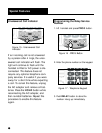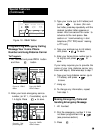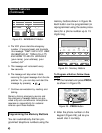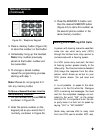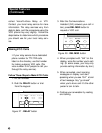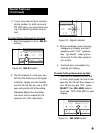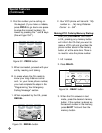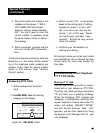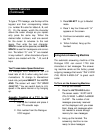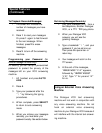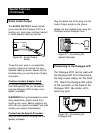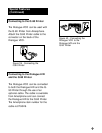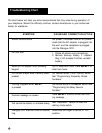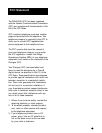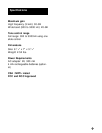
To type a TTY message, use the keys of the
keypad and their corresponding letters
(i.e. number 2 is also for letters A, B, and
C). On the screen, watch the character
above the cursor change as you repeat-
edly press the same key. When the
desired letter is shown, wait one second
for the cursor to advance to the next
space. Then enter the next character.
SPACE is used as the space bar, and BACK-
SPACE is used for backspace and correc-
tion. The letters “Q” and “Z” are located
in key number 1, other characters of punc-
tuation are created with the *, 0, and #
keys.
T
ext T
ransmission Speed Selection:
The Dialogue VCO defaults to the U.S
baud rate of 45.5 when using text com-
munications. To
change to International
baud rate, just pres
s SELECT
then
AUTO
ANS. The screen will read "INT SPEED
SELECTED." You can switch back to U.S.
speed in the same manner or by hanging
up.
Acoustic Coupling of a
TTY to the
Dialogue VCO:
1. Pick up the handset and place it
into TTY acoustic cups.
2. Dial number from the Dialogue
VCO keypad.
3. Press SELECT to go to Baudot
mode.
4. Press 1 key four times until "&"
appears on the screen.
5. Continue conversation using
the TTY.
6. When finished, hang up the
handset.
Using Auto Answering Machine
The automatic answering machine of the
Dialogue VCO can record 1728 total
characters in text messages. The answer-
ing machine sends out the factory preset
outgoing message that reads "THX U FOR
CLG, PLS LV A MSG GA" to greet each
caller.
To Turn on the Answering Machine:
1. Pick up the handset.
2. Press the AUTO ANS button.
The screen reads: “AUTO ANS
ON 00 MSG 1=READ 2=ERASE
3=OFF”. The number of old
messages previously received
will be displayed until you erase
them. Erase old messages when
not needed to ensure enough
memory for new messages.
3. Hang up the handset. The
answering machine is now
ready to take messages.
Special Features
(Continued)
16



